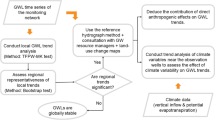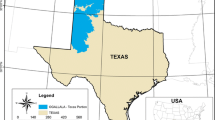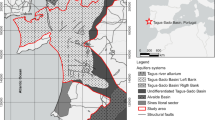Abstract
Regional groundwater monitoring in the Athabasca region of Alberta, Canada, provides information on groundwater quality and geochemical changes over time, including data useful for evaluating potential impacts of industrial activity such as oil sands mining and in situ operations. Data collected from over 5000 wells from the 1950s to 2014, including 161 wells from government’s monitoring network, were used to develop and apply bootstrap techniques for the detection of changes in groundwater geochemistry over time and at specific points in time. Increasing temporal anomalies were identified in Cl, TDS, B, and naphthenic acids in the McMurray formation across 2003 and 2008, while decreasing anomalies were found for SO4. Temporal variance for 15 indicators was quantified for a smooth bootstrap approach to arrive at stable values representative of the most recent samples taken from wells in the study area. Stable values revealed sampling bias in the Devonian, Grand Rapids, Empress, Channel Beverly, and Muriel Lake formations suggesting expansion of sampling may be necessary. Although temporal anomalies were found in the McMurray formation, sampling bias was not identified. The entropy and relative magnitude of time series were evaluated to identify candidate wells for continued observations, which consist of wells with low measurements and low entropy that are near active industry lease boundaries. Temporal anomalies, stable values, and entropy were combined into type-well information to provide plots for visual inspection and interpretation. Stable values are useful for regional mapping, for detecting future changes and trends, and for identifying areas of interest warranting further investigation.





















Similar content being viewed by others
References
AEP. (2012). Lower Athabasca region—Groundwater management framework. Alberta Environment and Parks (AEP).
Akena, A. M., & Christian, L. L. (1981). Water quality of the Athabasca oil sands area, Volume IV: An interim compilation of non AOSERP water quality data. Prepared for the Alberta Oil Sands Environmental Research Program by Alberta Environment, AOSERP Report L74.
Andriashek, L. D. (2003). Quaternary geological setting of the Athabasca oil sands (in situ) area, Northeast Alberta, Canada. Alberta Geological Survey Earth Sciences Report 2002–03.
Anttila, S., Ketola, M., Vakkilainen, K., & Kairesalo, T. (2012). Assessing temporal representativeness of water quality monitoring data. Journal of Environmental Monitoring, 14, 589–595.
Ba, A., & McKenna, S. A. (2015). Water quality monitoring with online change-point detection methods. Journal of Hydroinformatics, 17(1), 7–19.
Bachu, S., Underschultz, B.H., Hitchon, B., & Cotterill, D. 1993. Regional-scale subsurface hydrogeology in Northeastern Alberta. Alberta Geological Survey, Edmonton, AB. Retrieved April 1, 2000 from https://ags.aer.ca/document/BUL/BUL_061.pdf.
Birks, J., McClain, C., Manchuk, J., Deutsch, C., Yi, Y., Moncur, M., et al. (2019). Groundwater water quality monitoring near oil sands development: Regional insights from water management. Submitted to Geochemical Exploration, April 2019.
Birks, S. J., Moncur, M. C., Gibson, J. J., Yi, Y., Fennell, W. J., & Taylor, E. B. (2018). Origin and hydrogeological setting of saline groundwater discharges to the Athabasca River: Geochemical and isotopic characterization of the hyporheic zone. Applied Geochemistry, 98, 172–190.
Breitenberger, S., Efrosinin, D., Hofmann, N., & Auer, W. (2018). Comparison of classic and novel change point detection methods for time series with changes in variance. Electronic Journal of Applied Statistical Analysis, 11(1), 208–234.
Buhlmann, P. (2002). Bootstraps for time series. Statistical Science, 17(1), 52–72.
Camci, F. (2010). Change point detection in time series data using support vectors. International Journal of Pattern Recognition and Artificial Intelligence, 24(1), 73–95.
Deutsch, C. V., & Journel, A. G. (1998). GSLIB: Geostatistical software library and user’s guide. Oxford: Oxford University Press.
DiCiccio, T. J., & Efron, B. (1996). Bootstrap confidence intervals. Statistical Science, 11(3), 189–212.
Efron, B. (1979). Bootstrap methods—Another look at the jackknife. The Annals of Statistics, 7, 1–26.
Ghosh, M., & Sen, P. K. (1991). Bayesian pitman closeness. Communications in Statistics-Theory and Methods, 20, 3659–3678. https://doi.org/10.1080/03610929108830730.
Government of Alberta. (2017). Memorandum of understanding, respecting environmental monitoring of oil sands development. http://environmentalmonitoring.alberta.ca/wp-content/uploads/2018/03/OSM-MOU-December-1-2017.pdf.
Hardle, W., Horowitz, J., & Kreiss, J. (2013). Bootstrap methods for time series. International Statistical Review, 71(2), 435–459.
Helsel, D. R., & Hirsch, R. M. (2002) Statistical methods in water resources techniques of water resources investigations, book 4, chapter A3. U.S. Geological Survey.
Iwanyshyn, M., Ryan, M. C., & Chu, A. (2009). Cost-effective approach for continuous major ion and nutrient concentration estimation in a river. Journal of Environmental Engineering, 135(4), 218–224.
Javed, M. B., & Siddique, T. (2016). Thermally released arsenic in porewater form sediments in the Cold Lake area of Alberta, Canada. Environmental Science & Technology, 50, 2191–2199.
Johnson, R. A., & Bhattacharyya, G. K. (1996). Statistics: Principles and methods. New York: Wiley.
Kelly, E. N., Short, J. W., Schindler, D. W., Hodson, P. V., Ma, M., Kwan, A. K., & Fortin, B. L. (2009). Oil sands development contributes polycyclic aromatic compounds to the Athabasca River and its tributaries. Proceedings of the National Academy of Sciences, 106(52), 22346–22351.
Kendall, M. G. (1975). Rank correlation methods. London: Charles Griffin.
Keum, J., & Kaluarachchi, J. (2015). Calibration and uncertainty analysis using the SPARROW model for dissolved-solids transport in the upper Colorado River basin. Journal of the American Water Resources Association, 51(5), 1192–1210.
Lahiri, S. N. (1999). Theoretical comparisons of block bootstrap methods. The Annals of Statistics, 27(1), 386–404.
Lauzon, N., & Lence, B. J. (2010). Artificial intelligence techniques as detection tests for the identification of shifts in hydrometric data. Journal of Computing in Civil Engineering. https://doi.org/10.1061/(ASCE)CP.1943-5487.0000042.
Lorden, G. (1971). Procedure for reacting to a change in distribution. The Annals of Mathematical Statistics, 42, 1897–1908.
Mann, H. B. (1945). Non-parametric tests against trend. Econometrica, 13, 245–259.
Matrix Solutions Inc. (Matrix). (2015a). 2014 regional groundwater monitoring and wells rehabilitation program north Athabasca oil sands area regional groundwater monitoring network. Report Prepared for Alberta Environment.
Matrix Solutions Inc. (Matrix). (2015b). 2014 program report south Athabasca oil sands area regional groundwater monitoring network. Report Prepared for Alberta Environment and Sustainable Resource Development.
Moncur, M. C., Birks, S. J., Gibson, J. J., Yi, Y., & Paktunc, D. (2015). Predicting the mobilization of dissolved metals, organics and gas generation from aquifer sediments prior to in-situ operations. In GeoConvention 2015, Canadian Society of Petroleum Geologists, Calgary, AB, May 4–8.
Nordgaard, A., & Grimvall, A. (2006). A resampling technique for estimating the power of non-parametric trend tests. Environmetrics, 17, 257–267.
Palmer, M. D. (2001). Water quality modeling. ISBN: 978-0-8213-4863-5. https://doi.org/10.1596/0-8213-4863-9.
Page, E. S. (1954). Continuous inspection schemes. Biometrika, 41(1), 100–115.
Parker, J.M., & Tingley, K.W. (1980) History of the Athabasca oil sands region, 1860 to 1960's, Volume I: socio-economic developments. University of Alberta
Polansky, A. M. (2000). Stabilizing bootstrap-t confidence intervals for small samples. Canadian Journal of Statistics. https://doi.org/10.2307/3315961.
Ranger, M. J., & Gingras, M. K. (2003). Geology of the Athabasca oil sands—Field guide and overview. Calgary: Canadian Society of Petroleum Geologists.
Roberts, S. W. (1966). A comparison of some control chart procedures. Technometrics, 8(3), 411–430.
Rodvang, S. J., Mikalson, D. M., & Ryan, M. C. (2004). Changes in ground water quality in an irrigated area of southern Alberta. Journal of Environmental Quality-Ground Water Quality, 33(2), 476–487.
Siegmund, D., & Venkatraman, E. S. (1995). Using the generalized likelihood ratio statistic for sequential detection of a change-point. The Annals of Statistics, 23(1), 255–271.
Silverman, B. W., & Young, G. A. (1987). The bootstrap: To smooth or not to smooth? Biometrika, 74(3), 469–479.
Wald, A. (1945). Sequential tests of statistical hypotheses. The Annals of Mathematical Statistics, 16(2), 117–186.
Acknowledgments
This work was funded under the Oil Sands Monitoring Program, of the Government of Alberta (Alberta Environment and Parks) and Environment and Climate Change Canada, and is a contribution to the Program but does not necessarily reflect the position of the Program. A significant amount of data collection and processing was done by Don Jones of InnoTech Alberta to supplement the work.
Author information
Authors and Affiliations
Corresponding author
Additional information
Publisher's Note
Springer Nature remains neutral with regard to jurisdictional claims in published maps and institutional affiliations.
Rights and permissions
About this article
Cite this article
Manchuk, J.G., Birks, J.S., McClain, C.N. et al. Estimating Stable Measured Values and Detecting Anomalies in Groundwater Geochemistry Time Series Data Across the Athabasca Oil Sands Area, Canada. Nat Resour Res 30, 1755–1779 (2021). https://doi.org/10.1007/s11053-020-09801-5
Received:
Accepted:
Published:
Issue Date:
DOI: https://doi.org/10.1007/s11053-020-09801-5




